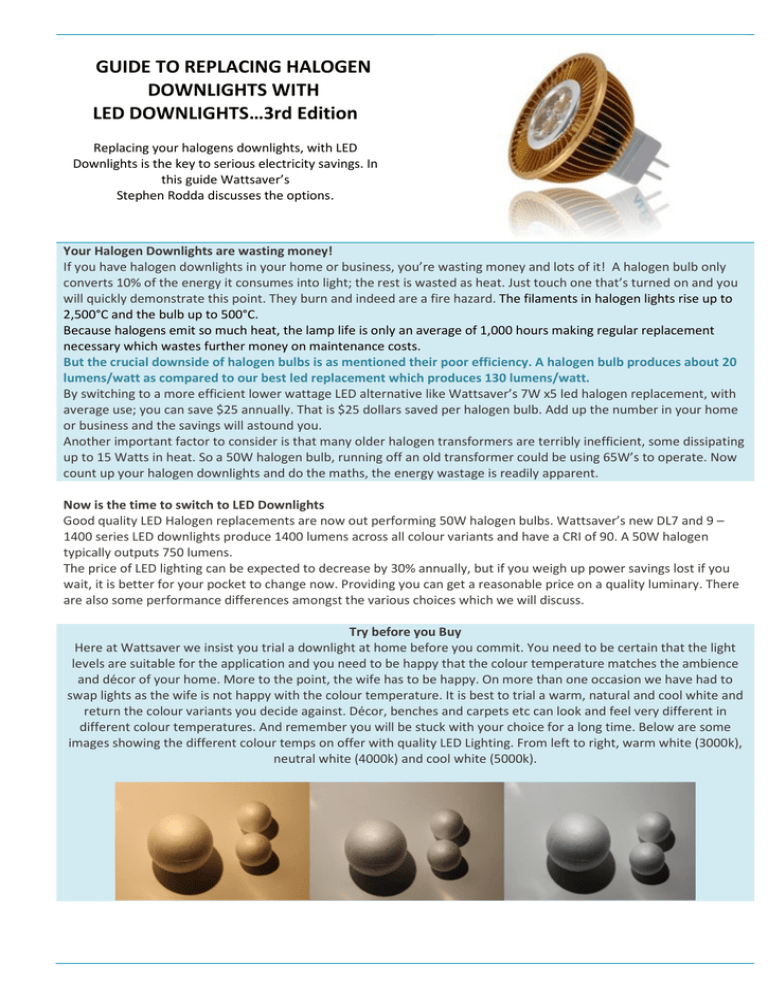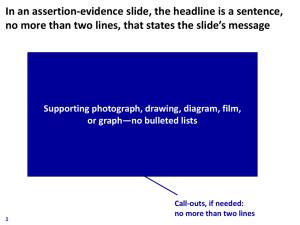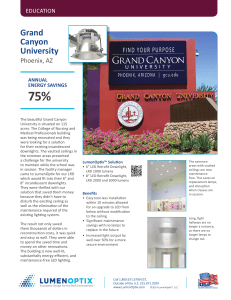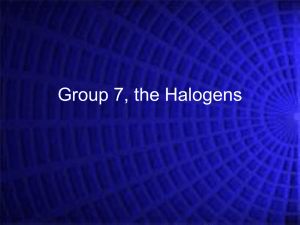Guide to replacing halogen downlights with LEDs
advertisement

GUIDE TO REPLACING HALOGEN DOWNLIGHTS WITH LED DOWNLIGHTS…3rd Edition Replacing your halogens downlights, with LED Downlights is the key to serious electricity savings. In this guide Wattsaver’s Stephen Rodda discusses the options. Your Halogen Downlights are wasting money! If you have halogen downlights in your home or business, you’re wasting money and lots of it! A halogen bulb only converts 10% of the energy it consumes into light; the rest is wasted as heat. Just touch one that’s turned on and you will quickly demonstrate this point. They burn and indeed are a fire hazard. The filaments in halogen lights rise up to 2,500°C and the bulb up to 500°C. Because halogens emit so much heat, the lamp life is only an average of 1,000 hours making regular replacement necessary which wastes further money on maintenance costs. But the crucial downside of halogen bulbs is as mentioned their poor efficiency. A halogen bulb produces about 20 lumens/watt as compared to our best led replacement which produces 130 lumens/watt. By switching to a more efficient lower wattage LED alternative like Wattsaver’s 7W x5 led halogen replacement, with average use; you can save $25 annually. That is $25 dollars saved per halogen bulb. Add up the number in your home or business and the savings will astound you. Another important factor to consider is that many older halogen transformers are terribly inefficient, some dissipating up to 15 Watts in heat. So a 50W halogen bulb, running off an old transformer could be using 65W’s to operate. Now count up your halogen downlights and do the maths, the energy wastage is readily apparent. Now is the time to switch to LED Downlights Good quality LED Halogen replacements are now out performing 50W halogen bulbs. Wattsaver’s new DL7 and 9 – 1400 series LED downlights produce 1400 lumens across all colour variants and have a CRI of 90. A 50W halogen typically outputs 750 lumens. The price of LED lighting can be expected to decrease by 30% annually, but if you weigh up power savings lost if you wait, it is better for your pocket to change now. Providing you can get a reasonable price on a quality luminary. There are also some performance differences amongst the various choices which we will discuss. Try before you Buy Here at Wattsaver we insist you trial a downlight at home before you commit. You need to be certain that the light levels are suitable for the application and you need to be happy that the colour temperature matches the ambience and décor of your home. More to the point, the wife has to be happy. On more than one occasion we have had to swap lights as the wife is not happy with the colour temperature. It is best to trial a warm, natural and cool white and return the colour variants you decide against. Décor, benches and carpets etc can look and feel very different in different colour temperatures. And remember you will be stuck with your choice for a long time. Below are some images showing the different colour temps on offer with quality LED Lighting. From left to right, warm white (3000k), neutral white (4000k) and cool white (5000k). The 3 species of LED Downlight 1. GU10 (Embedded 240V driver). The advantages of GU10’s are that you do not need an electrician to install, as it is a simple change of light bulb (assuming you already have GU10 halogens installed). The LED GU10 replacement fits into your existing downlight gimbal and the 2 pins plug directly onto a 240V socket. The disadvantage of GU10 downlights is that they are often limited in their lumen output (minimal room for a heatsink) and once the driver fails, the entire luminary must be thrown out. The point of LED downlights is that you will enjoy a long service life. However LED drivers are the weak link and embedded drivers get very hot, so a one to two year service life is probable in Australia. Of course the lighting shop is going to tell you that their LED GU10 will last 50,000 hours, but this is very unlikely to be true. Electronics, especially capacitors are very sensitive to heat and will not last 50,000 hrs. It is my considered opinion, if you have the choice, keep the LED driver external. If it fails in the future you can replace the driver and not have to throw out the entire LED. So in summary buy a quality GU10 to get the best life and be-aware the probable service life is 1 - 2 years. Trial the luminary first to determine if the light levels are adequate. 2. MR16 halogen replacements again offer a simple no electrician required swap over. Often they will function with existing halogen drivers. However again the output is limited to about 7-9Ws (700-900 lumens), as again there is limited room for a heatsink. It may be necessary to change old inefficient halogen transformers, or even modern switch-mode drivers where strobing occurs, meaning the electrician needs to be called and the cost becomes comparable with option 3 below. Dimming with existing halogen drivers can be problematic. 3. LED Downlight Kits. This is a complete fitting change with the gimbal surround and the LED Driver. I favour this option because of the following points: Performance, LED downlight fittings like Wattsavers 12W (DL7 and DL9 1400) out perform a regular 50W halogen by over 700 lumens. With an output of 1400 lumens you can in-fact reduce the number of lights in your home and business. As there is more room, it enables more heatsink and higher wattages and the use of COB chips and reflectors. The reflector and COB chip produce a halogen like throw of light, unlike lenses which as stated above produce a tight beam. Longevity, Because the driver is separate from the LED luminary, if the driver fails it can simply be replaced, leaving the LED luminary in service. The use of a dedicated LED driver also improves efficiency and means dimming can be integrated. The fact that a good sized heatsink can be incorporated means that the LED chips thermal parameters can be better accommodated. MR16 LED halogen replacements can produce very tight beams of light, even if the stated beam is 60 degree they are generally better suited for spotlighting and areas with lower light level requirements. So in summary LED MR16 halogen replacements are a convenient way to replace halogens in lower light applications where dimming is not required. Installing a dedicated LED driver will improve the life of the MR16 LED bulb and better facilitate dimming. X1 - 3.6 W LED MR16 bulb, These bulbs are now very cheap ($5) but have limited light output ( 60 -80 lumens/watt). However they are sufficient to replace halogens for spot light applications, over a bench top, garden lighting or in a retail environment spot lighting a product etc. I have sold many for use in real-estate shop windows, where they are used to highlight the listings. As the halogens are 50W and left on day and night, the electricity savings gained by switching to LEDs is significant. Wattsaver’s new 7W MR16/GU10 LED halogen replacement produces 700 lumens. We have tested numerous LED MR16 Halogen replacements and this product is head and shoulders above the others in performance. The workman ship is fantastic; this is the Roll Royce of LED lighting. This product utilizes Cree LEDs (USA) and is made in Taiwan, not China. This luminary will function with your current halogen drivers; however its life and efficiency will be improved by installing an LED driver. The X5 is an ideal replacement for a 50W halogen, in a spot lighting application and for lower ceilings and even as a primary light source where lower light levels are acceptable. It comes in 38, 50 and 120 beam angles. DL7-1400 and DL9-1400 The DL7/9-1400 series utilizes Edison-Opto's very latest chip technology. Edison has patented this technology and now lead the pack in terms of color rendering and efficiency. The 12W HR series chips produce 108 lumens/Watt, so the 1400 is bright. But the thing that is immediately apparent is the quality of the light. Objects look fantastic under this light, it adds an ambience to a room. The light is not glaring; it has a tone that feels natural and relaxing. With the HR series LED light has now equalled incandescent lighting for colour rendering and ambience. Even the cool white seems to reflect warmly off objects. LED downlighting has really arrived with the HR series chip. Wattsaver have added a prismatic reflector, which multiplies the light output ensuring an even lux illumination across the beam. This ensures (unlike other LED downlights on the market) we get an even spread of light, not a spot effect. The result is an LED downlight with an industry leading lumen/price/wattage ratio that performs like a halogen. Added to the 1400 series is a new improved heatsink design. Edison tell us that their LED chips must remain below 80 degrees, our new heatsink runs at a cosy 43 degrees. For more information on LED Downlights visit www.wattsaver.com.au


